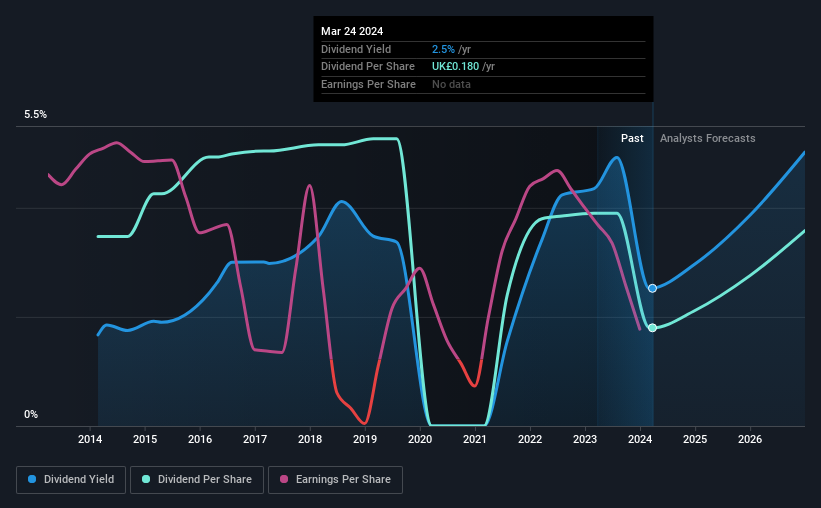Do These 3 Checks Before Buying Travis Perkins plc (LON:TPK) For Its Upcoming Dividend
Regular readers will know that we love our dividends at Simply Wall St, which is why it's exciting to see Travis Perkins plc (LON:TPK) is about to trade ex-dividend in the next three days. The ex-dividend date is one business day before a company's record date, which is the date on which the company determines which shareholders are entitled to receive a dividend. The ex-dividend date is important as the process of settlement involves two full business days. So if you miss that date, you would not show up on the company's books on the record date. Meaning, you will need to purchase Travis Perkins' shares before the 28th of March to receive the dividend, which will be paid on the 9th of May.
The company's next dividend payment will be UK£0.055 per share, on the back of last year when the company paid a total of UK£0.18 to shareholders. Based on the last year's worth of payments, Travis Perkins stock has a trailing yield of around 2.5% on the current share price of UK£7.132. Dividends are an important source of income to many shareholders, but the health of the business is crucial to maintaining those dividends. So we need to investigate whether Travis Perkins can afford its dividend, and if the dividend could grow.
Check out our latest analysis for Travis Perkins
Dividends are usually paid out of company profits, so if a company pays out more than it earned then its dividend is usually at greater risk of being cut. Last year Travis Perkins paid out 99% of its profits as dividends to shareholders, suggesting the dividend is not well covered by earnings. Yet cash flows are even more important than profits for assessing a dividend, so we need to see if the company generated enough cash to pay its distribution. It paid out 98% of its free cash flow in the form of dividends last year, which is outside the comfort zone for most businesses. Companies usually need cash more than they need earnings - expenses don't pay themselves - so it's not great to see it paying out so much of its cash flow.
Cash is slightly more important than profit from a dividend perspective, but given Travis Perkins's payouts were not well covered by either earnings or cash flow, we would be concerned about the sustainability of this dividend.
Click here to see the company's payout ratio, plus analyst estimates of its future dividends.
Have Earnings And Dividends Been Growing?
Businesses with strong growth prospects usually make the best dividend payers, because it's easier to grow dividends when earnings per share are improving. If business enters a downturn and the dividend is cut, the company could see its value fall precipitously. It's encouraging to see Travis Perkins has grown its earnings rapidly, up 30% a year for the past five years. Earnings per share have been growing rapidly, but the company is paying out an uncomfortably high percentage of its earnings as dividends. Generally, when a company is growing this quickly and paying out all of its earnings as dividends, it can suggest either that the company is borrowing heavily to fund its growth, or that earnings growth is likely to slow due to lack of reinvestment.
Another key way to measure a company's dividend prospects is by measuring its historical rate of dividend growth. Travis Perkins has seen its dividend decline 6.4% per annum on average over the past 10 years, which is not great to see. It's unusual to see earnings per share increasing at the same time as dividends per share have been in decline. We'd hope it's because the company is reinvesting heavily in its business, but it could also suggest business is lumpy.
Final Takeaway
Is Travis Perkins worth buying for its dividend? Earnings per share have been growing, despite the company paying out a concerningly high percentage of its earnings and cashflow. We struggle to see how a company paying out so much of its earnings and cash flow will be able to sustain its dividend in a downturn, or reinvest enough into its business to continue growing earnings without borrowing heavily. Overall it doesn't look like the most suitable dividend stock for a long-term buy and hold investor.
Having said that, if you're looking at this stock without much concern for the dividend, you should still be familiar of the risks involved with Travis Perkins. Case in point: We've spotted 3 warning signs for Travis Perkins you should be aware of.
If you're in the market for strong dividend payers, we recommend checking our selection of top dividend stocks.
Have feedback on this article? Concerned about the content? Get in touch with us directly. Alternatively, email editorial-team (at) simplywallst.com.
This article by Simply Wall St is general in nature. We provide commentary based on historical data and analyst forecasts only using an unbiased methodology and our articles are not intended to be financial advice. It does not constitute a recommendation to buy or sell any stock, and does not take account of your objectives, or your financial situation. We aim to bring you long-term focused analysis driven by fundamental data. Note that our analysis may not factor in the latest price-sensitive company announcements or qualitative material. Simply Wall St has no position in any stocks mentioned.

